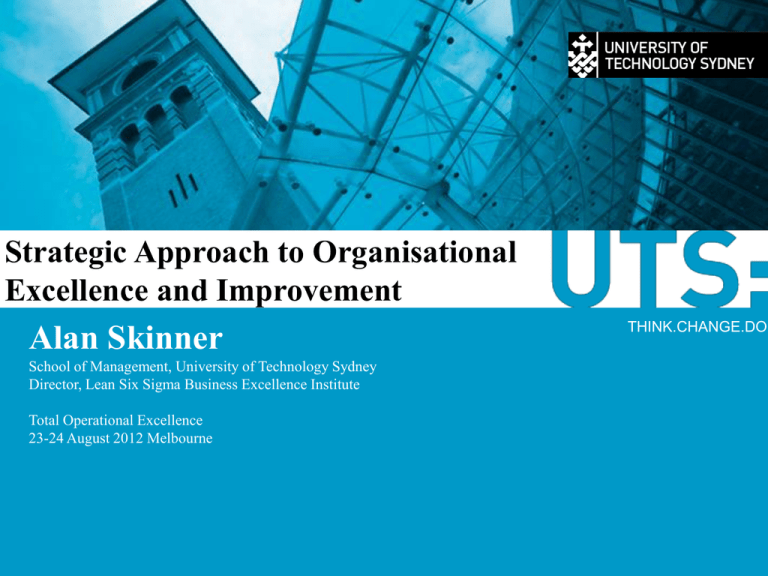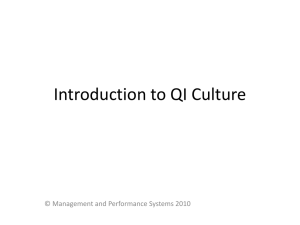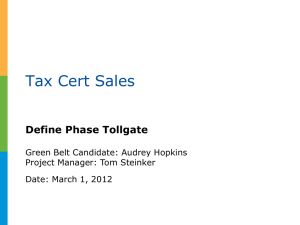Powerpoint Slides of Presentation
advertisement

Strategic Approach to Organisational Excellence and Improvement Alan Skinner School of Management, University of Technology Sydney Director, Lean Six Sigma Business Excellence Institute Total Operational Excellence 23-24 August 2012 Melbourne THINK.CHANGE.DO Agenda • The Excellence / Improvement or Lean Six Sigma Frameworks: A Paradigm fading? – Driving sustainable high performance through Lean Six Sigma in the context of Organisational Excellence – Creating a value stream fit to market – Highlighting the importance of deploying 5 leadership practices to drive excellence and improvement • Highlighting the recent research results on Lean Six Sigma practices Excellence Frameworks Influence of Edwards Deming Systems view of an organisation Sustainable high performance comes from … ..quality / price suited to the market ..predictable.. dependability.. Six Sigma idea ..low cost.. Lean idea Customer Focus STRATEGIC Implications of Deming’s Ideas Design the Value Stream to Fit the Market Execute to the Design Role of Improvement capability BUT… Many factors influence success – good quality being delivered Role of Improvement capability Gap between ideal and practice So need Continuous Improvement Always changing, adapting, improving Lean Six Sigma is a way of closing the Gaps that delivers results Reframing Lean Six Sigma – Improvement Lean Six Sigma is a way of closing the Gaps that delivers results So Lean Six Sigma can be seen as “bringing about change that is a measurable improvement and can be sustained” History of Improvement Methodologies Long before Lean and Six Sigma became BUZZ words they were part of the original teaching of Deming He never separated the ideas !! History of Improvement Methodologies • Influence of Deming and Business Excellence Frameworks • Six Sigma - Motorola - Bill Smith – mid 1980s • Lean - Toyota • Popularised in many companies • Family of approaches develop : – Core Model is DMAIC • Move to Lean Six Sigma History of Improvement Methodologies Influence of Deming and Business Excellence Frameworks Organisational Excellence Models Leadership Creating Environment for Excellence Strategic Thinking, Management and Execution Enabling People to Work on the Organisation Gathering and Deploying Customer and Market Intelligence Sustaining Operational Excellence Balanced Sustained High Performance that Delivers Value to all Stakeholders Integrated System of Measures consistent with Strategy and Design Key Supporting Models Practices and Tools Customer Experience Design Value Stream Design Leadership for Business Improvement (LBI) Leadership Creating Environment for Excellence Strategy Maps Strategic Thinking, Management and Execution Gathering and Deploying Customer and Market Intelligence Interlinking Critical Measures Balanced Scorecards Enabling People to Work on the Organisation Balanced Sustained High Performance that Delivers Value to all Stakeholders Sustaining Operational Excellence Integrated System of Measures consistent with Strategy and Design System or Family of Measures Customer Experience (TCE) Research Stability and Capability Analyses Business Process Management (BPM) Organisational Excellence Assessments Lean Six Sigma / Organisational Improvement Methods 5 Activities for Leaders to Focus the Organisation on Improvement 1 Purpose •Purpose •Mission •Vision •Governance 2 Planning for Improvement 4 3 System for Obtaining Info •Strategic objectives •Improvement efforts •Resources Managing Individual & Team Improvement Efforts Systems View of the Organization Black Belts Green Belts Improvement Plans Family of Measures/ Scorecards Financial Customer 5 Enablers Operations Employee Training…Recognition… Communication Model is based on Content from “Quality as a Business Strategy” (API, 1998) Myths about Lean Six Sigma • • • • • Recent Management Fad Very tactical or operational Focused internally Suited only to manufacturing No room for Creativity Research and Literature Projects Submitted Journal Literature Highlighting Research from Projects Submitted • 150 + projects over years • Sample 30 taken • Quick review of patterns emerging Breakdown of Projects by Industry Technology 9% Financials 24% Industrial 24% Consumer services 5% Health Care 19% Consumer Goods 19% Breakdown of Projects by Process Inventory Mgt 5% Manufacturing 16% Sales Process 21% Packaging 5% Service 26% Admin 27% Breakdown of Projects by Problem Forecast Inaccurate 7% High Inventory 7% Not delivered in full 5% Unnecessary Work 2% Customer Impact 17% Reduced sales 5% Wasted movement 2% Wasted space 2% Product/Service Defects 7% Admin Errors 5% Long cycle time 10% Rework 10% High Costs 12% Wasted Labour Time 5% Over Production 4% Frequently Cited Causes No Process Control / process errors Inaccurate Data Interpretation Tool related & Interface between tools Criteria Goals Targets Unclear Unknown Lack of Preparation Planning Scheduling Process Complexity/Flexibility Poor understanding of Demand Lack of Skills / Knowledge Lack of Management of Information Poor communication beyond org Poor Equipment Lack of Resources Role Understanding Poor Design 0 10 20 % Reported 30 Frequently Cited Solutions Training and assessment Task redesign/simplify/reduce Tool redesign/creative use/automation Use/provision/access of… Visual Management Error proofing Monitoring Testing Tracking Evaluation Planning Preparation Procedure / Troubleshooting… Role carification/ownership Accurate targets/goaling… Communication engagement with… Recognition aligned to gaols Layout of process/machines Change Design of Product/service New equipment 0 2 4 6 8 % 10 12 14 16 % Improvement Level of Impact of Projects – from Baseline More 100 90 80 70 60 50 40 30 20 10 0 5 10 15 20 Frequency 25 30 35 Range of ROI Cited 8 120.00% 7 100.00% Frequency 6 80.00% 5 4 60.00% 3 40.00% 2 20.00% 1 0 0.00% ROI S Research and Literature Projects Submitted Journal Literature Reviews of Research and Literature • Conceptual Discussion, Opinions, Research – Reviews and Studies over 4 decades 1970s -2012 – 500+ articles – Different Industries – Different Countries Overview of Research Coverage • Conceptual Discussion and History reviews – Theory and Model Building • • • • • • Critical Success Factors Link to Results Measurement, Analysis, Tools, Models Innovation and Design of Experiments Action Research, PDSAs, Learning and Change Application settings for Lean/Six Sigma Organisational Excellence – broader area Critical Success Factors – Research Literature 1. Management Commitment 6. Project Selection 2. Reward Recognition 7. Stories 3. Competency of Belts 8. Dashboard 4. Investment 9. Culture 5. Assessment of Results Critical Success Factors – Research Literature 1. Management Commitment 2. Reward Recognition 6. Link to Strategy & Project Selection 3. Competency of Belts 7. Stories 4. Investment 8. Dashboard 5. Assessment of Results 9. Culture Critical Success Factors – Research Literature Other Factors Understanding Customers Understanding Business Infrastructure and Resources Tools and Methods Skills and Training Application Beyond Core Communication Success Factors Themes from Project Reports Measurement, Use of data, Variation, ROI Concepts / Holding to Methodology Skilled Use of Tools and Techniques Effective Change Management Practices Senior Management Support Solution Development, ideas, testing Effective Facilitation Teamwork/engagement & ownership Use of Learning Cycles Business & Process Understanding Control practices to sustain effects Customer engagement and analysis Effective Analyse Phase 0 5 10 15 % of Responses 20 Thank You Questions Interested in Research Participation Please contact me Frequently Cited Causes








